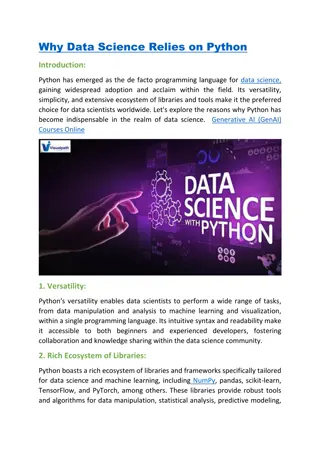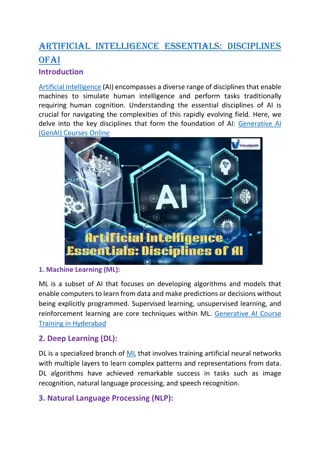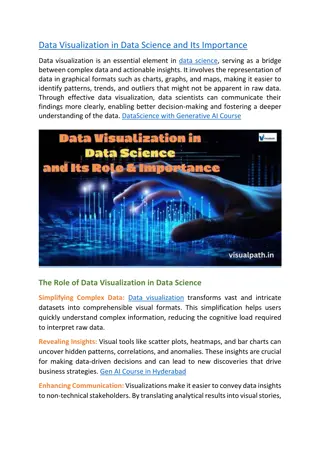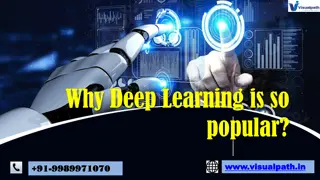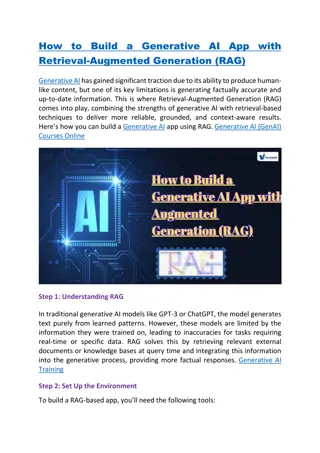Data Science with Generative AI Course Generative AI Online Training Course
nGenerativeAI(GenAI)CoursesOnline -Visualpath offers expert-led DataScience with Generative AI Course of the highest quality for learners worldwide. All training sessions are recorded and available for reference, along with presentation materials. Schedule A free Demo Call 91-9989971070 nVisit our Blog: //visualpathblogs.com/nWhatsApp: // /catalog/919989971070nVisit: //visualpath.in/data-science-with-generative-ai-online-training.htmln
Download Presentation

Please find below an Image/Link to download the presentation.
The content on the website is provided AS IS for your information and personal use only. It may not be sold, licensed, or shared on other websites without obtaining consent from the author.If you encounter any issues during the download, it is possible that the publisher has removed the file from their server.
You are allowed to download the files provided on this website for personal or commercial use, subject to the condition that they are used lawfully. All files are the property of their respective owners.
The content on the website is provided AS IS for your information and personal use only. It may not be sold, licensed, or shared on other websites without obtaining consent from the author.
E N D
Presentation Transcript
Understanding Understanding Probability Probability Distributions Distributions In Data Science In Data Science + +91 91- -9989971070 9989971070 www.visualpath.in www.visualpath.in
Understanding Probability Distributions Probability distributions are fundamental concepts in statistics and data analysis, encapsulating how distributed over the values of a random variable. They provide a mathematical framework to describe the likelihood of different outcomes (random) process, making them essential in fields ranging from finance to physics to machine learning. probabilities are in a stochastic www.visualpath.in
Defining Probability Distributions At its core, a probability distribution assigns a probability to each possible outcome of a random variable. For variables, this is often represented by a probability mass function (PMF), which gives the probability that the variable takes on each of its possible values. For continuous random variables, the probability density function (PDF) describes the likelihood of the variable falling within a particular range of values. discrete random www.visualpath.in
Key Types of Probability Distributions Discrete Distributions: Binomial Distribution: Represents the number of successes in a fixed number of independent Bernoulli trials, each with the same probability of success. It's used in scenarios like predicting the number of heads in a series of coin flips. Poisson Distribution: Models the number of times an event occurs within a fixed interval of time or space. It's useful for counting events like the number of emails received in an hour. www.visualpath.in
Continuous Distributions: Normal Distribution: Also known as the Gaussian distribution, it is characterized by its bell-shaped curve. It's defined by two parameters: the mean (average) and the standard deviation (spread). Many natural phenomena, such as heights and test scores, follow a normal distribution. Exponential Distribution: Describes the time between events in a Poisson process, where events occur continuously and independently at a constant average rate. It's often used in survival analysis and queuing theory. www.visualpath.in
Characteristics of Probability Distributions Mean (Expected Value): The long-run average value of repetitions of the experiment it represents. For a discrete random variable, it is calculated as the sum of all possible values weighted by their probabilities. Variance: Measures the dispersion of the random variable's values around the mean. It provides insight into the variability within the distribution. Skewness and Kurtosis: Skewness describes the asymmetry of the distribution, while kurtosis indicates the "tailedness" of the distribution compared to a normal distribution. www.visualpath.in
Applications Probability distributions are ubiquitous in statistical modeling and inference. They are used to: Model and predict real-world phenomena. Inform decision-making processes under uncertainty. Form the basis of inferential statistics, where conclusions about a population are drawn from sample data. www.visualpath.in
In machine learning, understanding probability distributions is crucial for designing algorithms that make predictions, classify data, and generate new samples. For instance, generative models Autoencoders (VAEs) Adversarial Networks probability distributions to create realistic data. like and (GANs) Variational Generative rely on www.visualpath.in
In summary, probability distributions are powerful tools that describe how probabilities are possible outcomes, backbone for statistical analysis and decision-making environments. allocated providing across the in uncertain www.visualpath.in
CONTACT For More Information About DataScience Training Institute in Hyderabad Address:- Flat no: 205, 2nd Floor Nilagiri Block, Aditya Enclave, Ameerpet, Hyderabad-16 Ph No : +91-9989971070 Visit : www.visualpath.in E-Mail : online@visualpath.in
THANK YOU Visit: www.visualpath.in



